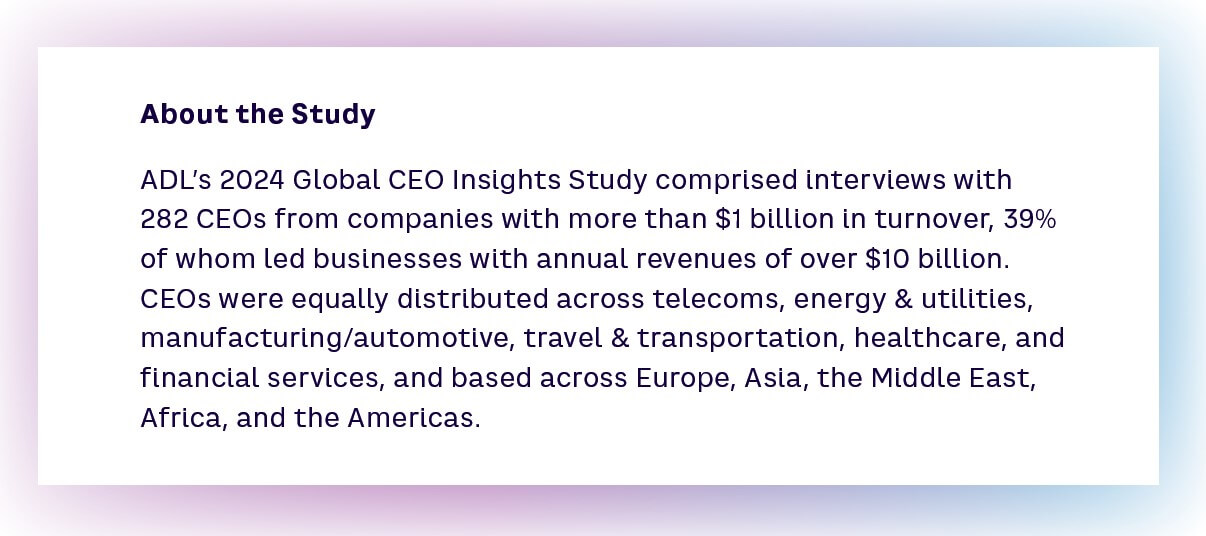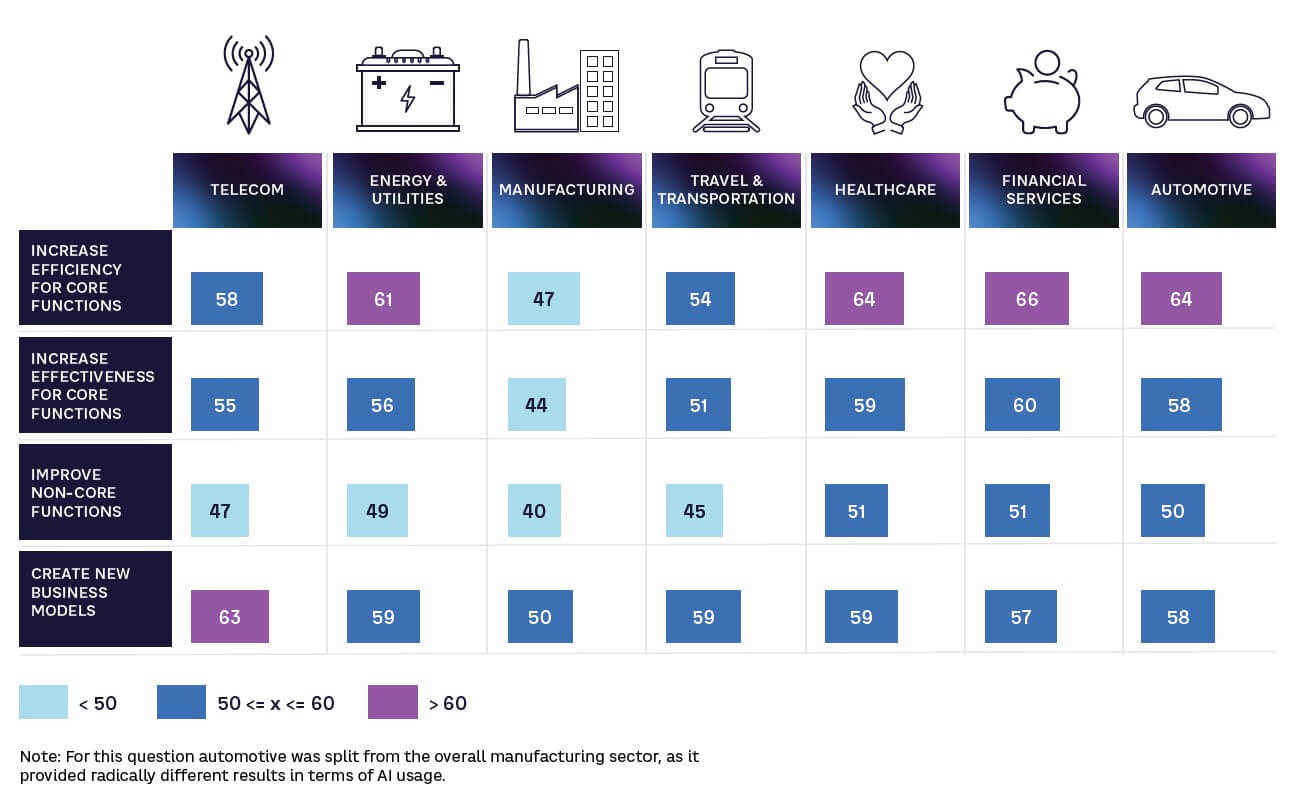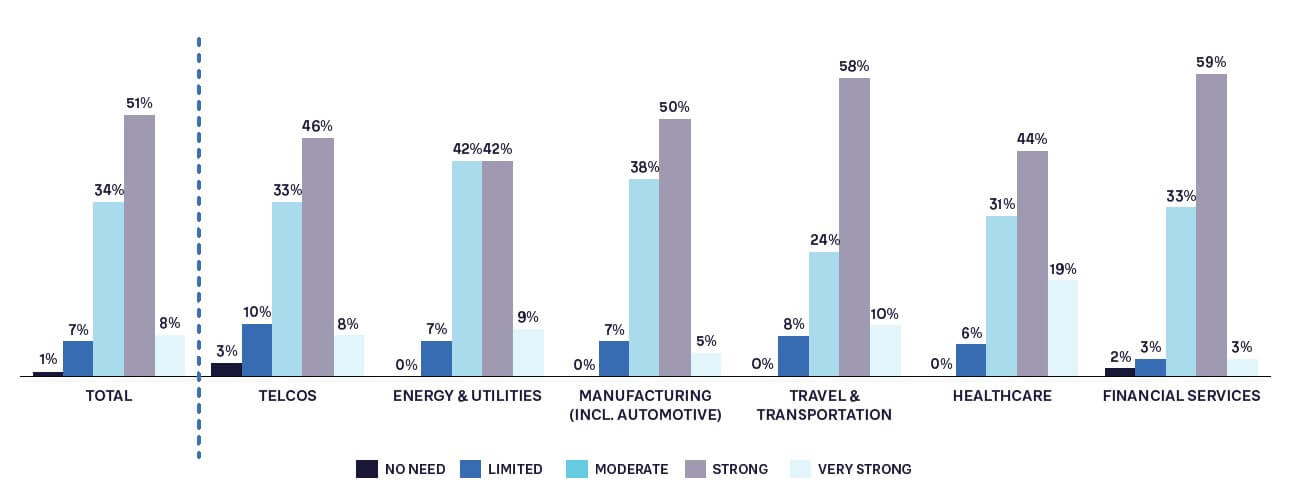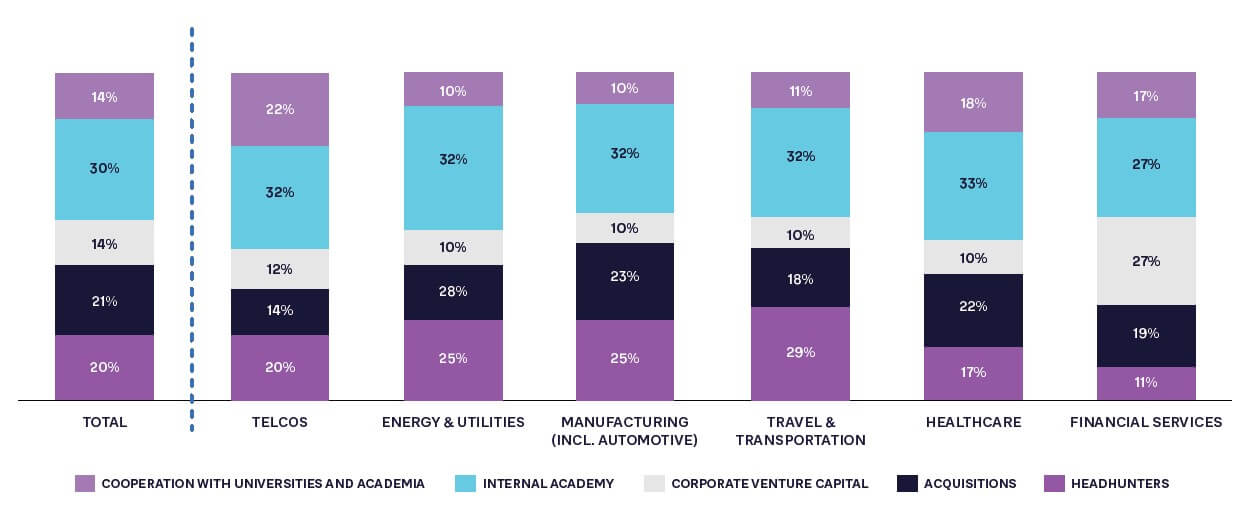12 min read • Organization & transformation, Strategy
Optimistic global CEOs focus on people and skills in an AI future

Embracing the opportunities that artificial intelligence (AI) and talent together can unlock, CEOs are looking beyond the current instability, and increasingly confident about the future prospects for their organizations and the wider economy. Two-thirds are highly positive about the global outlook over the next three to five years, a major increase from 2023. Given that global tensions have worsened over the last 12 months, with conflict in the Middle East, disruptions to Red Sea supply chains, and the continuing war in Ukraine, this optimism is dramatic and heartening. CEOs understand that they have to operate in a volatile, uncertain, complex, ambiguous world, and be agile, responsive, and resilient.
Despite the fact that we’re entering an age defined by AI and automation, people remain crucial to long-term business growth. That’s one of the key findings of the second global Arthur D. Little CEO Insights Study. This in-depth research among CEOs from companies with over US $1 billion in revenues finds that as companies embrace AI, they are investing equally heavily in reskilling their people to maximize its benefits. This picture holds true across the different regions of the world and within the six sectors (telecoms, energy & utilities, manufacturing, travel & transportation, healthcare, and financial services) that the study covered.
As we’ll explain in this article, they are investing for growth and aiming to develop their people internally to unlock the potential of AI and drive success. Looking to the future, they want to help shape the next generation of leaders based on attributes such as ethical behavior, sustainability, diversity, and inclusion, and focus on the customer.
CEOs See Technology as the Principal Growth Driver in an Uncertain World
Technology innovation remains the most critical driver for growth, according to CEOs — a fact that has not changed since 2023. One-quarter of all CEOs listed it as one of the top two most important factors, rising to 34% in South America and 29% in North America. This was ahead of areas such as raw material/energy prices, supply chain pressures, and disruptive competitors.

CEOs recognize that the ground rules of business have changed and that stable markets that evolve incrementally are gone forever. They need to operate in an unstable world, with 80% of CEOs expecting to pay more management attention to volatility, uncertainty, and related topics over the next three to five years. CEOs aim to combat this volatility through greater customer focus, closer links with suppliers, scenario planning, and, most of all, technology and people. On the technology side, they are aiming to implement more sophisticated risk management tools, improve business intelligence, increase efficiency, and provide greater flexibility within operations.
“We are making investments in cutting-edge technologies that can provide us with a competitive advantage in erratic markets.” CEO, healthcare
Hearteningly, half of CEOs feel that their company has a high level of readiness to adapt to greater uncertainty, with 16% feeling that their structures are superior to those of the wider market. This shift in adaptation is led by larger organizations, of which 28% judge their capabilities as superior.
“We are going to put more effort into becoming more flexible and agile so that we can react fast to shifting market conditions. This entails implementing adaptable business strategies and encouraging an innovative culture.” CEO, financial services
Empowering Talent to Meet Changing Needs
CEOs agree that the second key element for success in this environment is their people. Here they recognize a need to invest in training and reskilling to ensure their employees can support their more agile operations. On average, 92% of CEOs feel that at least some reskilling is required for success. Nearly 70% of CEOs from $10 billion+ companies feel that they still have a strong or very strong need to reskill staff to adapt to a more volatile environment, compared to just over half of the $1–10 billion turnover group.
Agility has to be led from the top, with CEOs taking a much more hands-on approach to running their businesses. As well as driving faster change and improved strategic decision making, the CEO Insights Study shows that they are focusing on empowering their people with the right technology, access to knowledge, and relevant skills to create truly agile organizations that are flexible and responsive to current and future market conditions.
CEOs Welcome the Rise of AI and Are Looking to Tap Into Its Benefits
The record-fast rise of generative AI, and the growing maturity of AI more generally, offers transformative possibilities (and challenges) to businesses, whatever sector they are in. As the responses of CEOs show, in many ways, progress has been swift. Almost all executives claim to have implemented an AI strategy within at least one department of their organization. Nearly half say they already have a strategic view of AI across the business.
However, turning vision into reality is more complex. Only 13% of CEOs have so far adopted a holistic, compelling, and companywide AI strategy, demonstrating that they are still on a transformation path to fully understand the impact of AI and integrate it across the organization. In many ways this is unsurprising — fully benefiting from AI requires enormous structural and workforce change, which will only be felt over time. There are major challenges in moving from a strategic view to an actual strategy and then implementing it.
The furthest advanced in AI strategy are companies within Asia (75% having a companywide strategy or strategic view), those in financial services (79%), and $10 billion+ organizations (67%). A clear divide is shown between organizations that feel they are leading their markets, of which 24% have a companywide strategy in place, and laggards, none of which have implemented such a compelling strategy.
What Are CEOs Using AI For?
Backing up the fact that organizations are early in their AI transformation, analysis shows that CEOs are predominantly focused on using AI to make core functions better by increasing efficiency and effectiveness, such as through automation. Efficiency and effectiveness are the leading use cases in the majority of sectors,[1] as shown in Figure 1. The sole exceptions are telecoms, travel/transportation, and manufacturing, which are moving beyond efficiency to use AI to create innovative new business models. Essentially, while CEOs recognize that AI is disruptive, they also understand that the real step changes in transforming their business are yet to come, and that they have work to do to harness AI at a deeper level.

“We will take advantage of technology, such as artificial intelligence and data analytics, which can give us real-time insights and support employees in making wise decisions in dynamic market environments.” CEO, telecoms
“We are using AI and advanced analytics to find patterns, forecast trends, and evaluate risks in volatile and complex markets.” CEO, financial services
Why AI Increases the Importance of Humans
AI drives the transformation of the entire organization — its structures and business models and the markets it operates in. In order to harness and successfully exploit the potential of AI, CEOs understand that they require new skills across their workforce. Reskilling is therefore vital — and needs to be far reaching and transformative to match changing corporate needs. This is less about the automatic replacement of humans with AI. Rather, it is about ensuring that as roles change, employees are equipped to work with and manage AI to thrive in an unpredictable world and deliver on corporate goals.
“To create more intelligent strategies, we have combined human expertise with AI capabilities.” CEO, healthcare
Recognizing this requirement for change, 99% of CEOs see the need for at least some reskilling, up from 88% in 2023 (see Figure 2). The scale of the issue has dramatically increased over the last 12 months thanks to the speed and wide-ranging impact of AI’s rapid rise:
-
Nearly 60% of CEOs now see a strong or very strong requirement to reskill their employees, up from just 13% in 2023.
-
Nearly 60% of manufacturing CEOs see a strong/very strong need to reskill in 2024, compared to 5% in 2023.
-
Over 60% of financial services CEOs see a strong/very strong need to retrain their people, compared to 10% in 2023.

“In today’s dynamic and fast-paced business environment, the lesson is to train for adaptability.” CEO, energy & utilities
Changing Cultures to Thrive in an AI World
Alongside investing in training and talent, CEOs understand that their cultures have to transform. They need to be able to attract and retain talent with the right skills, attitudes, and behaviors to successfully exploit AI. This requires change, particularly in traditional, hierarchical businesses in which promotion is linked to length of tenure rather than innate capabilities. Digital natives from Generation Z are increasingly important. The article “The Future Workforce: Recruiting and Retaining Vital Generation Z Talent,” elsewhere in this issue of Prism, provides more details on how to meet their specific requirements by reshaping processes, cultures, and practices.
“We will increase our investments in employee training and development, cultivate a favorable workplace atmosphere, and execute flexible workforce tactics to adjust to evolving business circumstances.” CEO, healthcare
For global organizations, successfully managing AI and volatility through traditional, centralized structures is difficult. Instead, new levels of leaders across the business need to be empowered and trained to make decisions in a faster, more informed way, as well as innovate based on their particular knowledge of specific areas and market conditions.
“In order to enable our staff to react swiftly to shifting market conditions, we will work to provide them greater freedom to make decisions at their level.” CEO, financial services
“We place a high priority on leadership development, skill enhancement, and employee training in order to produce a highly competent and flexible workforce that can successfully go through shifting market conditions and contribute to the success of the organization.” CEO, telecoms
Greater Focus on Internal Talent Development to Balance External Recruitment
Previously, CEOs relied heavily on external sources for new capabilities and talent, primarily headhunters and cooperation with universities. However, in 2024 this focus has shifted, with the largest percentage (30%) now looking to internal academies to deliver talent and skills (see Figure 3), up from 21% in 2023.

This increasingly balanced view is driven by multiple factors, including the difficulty of finding AI talent given global skills shortages, a need to retain existing high-achieving talent and experience, and a growing realization that technical knowledge needs to be married to business understanding to deliver effective results tailored to the specific company and its objectives.
CEOs see developing their own people as delivering faster results, as new skills such as AI can be layered on their existing expertise, without the requirement to train new joiners on company operations from scratch. Internal academies also support the growing focus on lifelong learning that staff (particularly Generation Z or Millennials) are demanding from their employers. These employees also increasingly want to work for companies that share their sense of purpose and values, particularly around ESG, something that CEOs recognize and are acting on.
“We are gaining the trust of our staff members by being transparent about the company’s objectives, difficulties, and decision making procedures.” CEO, manufacturing
While the majority of sectors are taking a balanced approach to future talent, variations are shown between sectors. CEOs in the telecoms, manufacturing, travel & transportation, and healthcare sectors are the most enthusiastic about internal academies, while healthcare organizations are also increasing their focus on building talent through acquisition, at the expense of traditional cooperation with universities and academia. Energy & utilities CEOs also aim to primarily source new talent via acquisition, while financial services are looking to corporate venture capital, investing in fintechs to plug their skills gaps. Travel & transportation is the only sector to increase (slightly) its reliance on headhunters, although they are seen as an integral part of the recruitment mix in most sectors.
Creating the Next Generation of Leaders
What are the skills that CEOs need for the future? To find out, CEOs were also asked for leadership advice they’d provide to younger generations, based on their own experiences and how the business world is changing. Five themes stood out:
-
Focusing on sustainability and social issues, including diversity and digital inclusion
-
Behaving ethically and morally at all times and demonstrating the company purpose, reinforced by strong governance processes
-
Being flexible, adaptable, and entrepreneurial, and not fearing failure
-
Putting the customer first and continually listening to their needs
-
Embracing lifelong learning, staying curious, and having a commitment to gaining new skills while supporting/mentoring the next generation
“Within your company, promote inclusion and diversity. Encourage an environment where people with different experiences, viewpoints, and backgrounds are valued at work.” CEO, utilities
This demonstrates that today’s CEOs are fully aware that they need to have a radically different vision of what success involves than those of the past. They are moving well beyond revenues and market share toward achieving a better balance between financial metrics and ethical/environmental factors, essentially aiming to leave the world (and their companies) in a better place when they move on from their roles.
“Encourage creativity and a willingness to explore novel concepts. A firm with an entrepreneurial atmosphere might be able to develop business strategies that give it an edge over competitors in volatile markets.” CEO, automotive
Insights for the Executive
Overall, the 2024 CEO Insights Study clearly shows that senior business leaders of the world’s biggest companies are optimistic about the future and focusing on AI and human skills to achieve their sustainable growth objectives.
1. Embrace Radical Change Through AI
CEOs have ambitious plans for technology, particularly AI. This has the potential to transform their entire business, but they need to translate their plans and strategies into concrete, companywide programs. Currently, many AI use cases focus on making existing processes more efficient and effective — CEOs need to go beyond this to deploy AI to innovate and target new opportunities to reap maximum benefit and competitive advantage. They need to embrace the transformative changes to their business models that AI enables, opening new markets, opportunities, and partnerships.
2. Keep Pace with Innovation
The rapid rise of AI demonstrates how quickly new technologies can move from the periphery into the mainstream. CEOs must therefore keep a watch on other breakthrough technologies, such as quantum computing and autonomous vehicles, monitoring progress and understanding how they might impact their business once they mature.
3. Understand that AI Plus Human Skills Maximizes Results
Even the most powerful AI tools won’t deliver impact if they are not adopted across the company. To democratize AI, ensure that tools are available and usable by relevant parts of the workforce. By supporting people with AI, you can improve their performance — and that of the wider company.
4. Concentrate on Internal People, Skills, and Capabilities
Ensure that companies have the right internal skills and capabilities to deliver an ambidextrous, agile learning organization. This relies on fundamental reskilling of the workforce to ensure they have the correct talent mix to drive the business forward. CEOs must therefore focus heavily on ensuring they have access to these skills across the business through internal programs/academies, cultural change to support the shift to lifelong learning, and communication/change management to inform, educate, and engage staff at a time of disruption. Given skills shortages around AI, attracting talent and reskilling may require unconventional approaches, from creating standalone AI subsidiaries to companywide AI training programs.
5. Create the Next Generation of Leaders
The skills and attributes of a successful CEO have shifted — with a need to balance profitability and financial success with ethical, sustainable behavior. Today’s CEOs should look to nurture the next generation of leaders, providing them with support and mentorship to develop their talents for the future.
Note
[1] For this question, automotive was split from the overall manufacturing sector, as it provided radically different results in terms of AI usage.

12 min read • Organization & transformation, Strategy
Optimistic global CEOs focus on people and skills in an AI future

DATE

Embracing the opportunities that artificial intelligence (AI) and talent together can unlock, CEOs are looking beyond the current instability, and increasingly confident about the future prospects for their organizations and the wider economy. Two-thirds are highly positive about the global outlook over the next three to five years, a major increase from 2023. Given that global tensions have worsened over the last 12 months, with conflict in the Middle East, disruptions to Red Sea supply chains, and the continuing war in Ukraine, this optimism is dramatic and heartening. CEOs understand that they have to operate in a volatile, uncertain, complex, ambiguous world, and be agile, responsive, and resilient.
Despite the fact that we’re entering an age defined by AI and automation, people remain crucial to long-term business growth. That’s one of the key findings of the second global Arthur D. Little CEO Insights Study. This in-depth research among CEOs from companies with over US $1 billion in revenues finds that as companies embrace AI, they are investing equally heavily in reskilling their people to maximize its benefits. This picture holds true across the different regions of the world and within the six sectors (telecoms, energy & utilities, manufacturing, travel & transportation, healthcare, and financial services) that the study covered.
As we’ll explain in this article, they are investing for growth and aiming to develop their people internally to unlock the potential of AI and drive success. Looking to the future, they want to help shape the next generation of leaders based on attributes such as ethical behavior, sustainability, diversity, and inclusion, and focus on the customer.
CEOs See Technology as the Principal Growth Driver in an Uncertain World
Technology innovation remains the most critical driver for growth, according to CEOs — a fact that has not changed since 2023. One-quarter of all CEOs listed it as one of the top two most important factors, rising to 34% in South America and 29% in North America. This was ahead of areas such as raw material/energy prices, supply chain pressures, and disruptive competitors.

CEOs recognize that the ground rules of business have changed and that stable markets that evolve incrementally are gone forever. They need to operate in an unstable world, with 80% of CEOs expecting to pay more management attention to volatility, uncertainty, and related topics over the next three to five years. CEOs aim to combat this volatility through greater customer focus, closer links with suppliers, scenario planning, and, most of all, technology and people. On the technology side, they are aiming to implement more sophisticated risk management tools, improve business intelligence, increase efficiency, and provide greater flexibility within operations.
“We are making investments in cutting-edge technologies that can provide us with a competitive advantage in erratic markets.” CEO, healthcare
Hearteningly, half of CEOs feel that their company has a high level of readiness to adapt to greater uncertainty, with 16% feeling that their structures are superior to those of the wider market. This shift in adaptation is led by larger organizations, of which 28% judge their capabilities as superior.
“We are going to put more effort into becoming more flexible and agile so that we can react fast to shifting market conditions. This entails implementing adaptable business strategies and encouraging an innovative culture.” CEO, financial services
Empowering Talent to Meet Changing Needs
CEOs agree that the second key element for success in this environment is their people. Here they recognize a need to invest in training and reskilling to ensure their employees can support their more agile operations. On average, 92% of CEOs feel that at least some reskilling is required for success. Nearly 70% of CEOs from $10 billion+ companies feel that they still have a strong or very strong need to reskill staff to adapt to a more volatile environment, compared to just over half of the $1–10 billion turnover group.
Agility has to be led from the top, with CEOs taking a much more hands-on approach to running their businesses. As well as driving faster change and improved strategic decision making, the CEO Insights Study shows that they are focusing on empowering their people with the right technology, access to knowledge, and relevant skills to create truly agile organizations that are flexible and responsive to current and future market conditions.
CEOs Welcome the Rise of AI and Are Looking to Tap Into Its Benefits
The record-fast rise of generative AI, and the growing maturity of AI more generally, offers transformative possibilities (and challenges) to businesses, whatever sector they are in. As the responses of CEOs show, in many ways, progress has been swift. Almost all executives claim to have implemented an AI strategy within at least one department of their organization. Nearly half say they already have a strategic view of AI across the business.
However, turning vision into reality is more complex. Only 13% of CEOs have so far adopted a holistic, compelling, and companywide AI strategy, demonstrating that they are still on a transformation path to fully understand the impact of AI and integrate it across the organization. In many ways this is unsurprising — fully benefiting from AI requires enormous structural and workforce change, which will only be felt over time. There are major challenges in moving from a strategic view to an actual strategy and then implementing it.
The furthest advanced in AI strategy are companies within Asia (75% having a companywide strategy or strategic view), those in financial services (79%), and $10 billion+ organizations (67%). A clear divide is shown between organizations that feel they are leading their markets, of which 24% have a companywide strategy in place, and laggards, none of which have implemented such a compelling strategy.
What Are CEOs Using AI For?
Backing up the fact that organizations are early in their AI transformation, analysis shows that CEOs are predominantly focused on using AI to make core functions better by increasing efficiency and effectiveness, such as through automation. Efficiency and effectiveness are the leading use cases in the majority of sectors,[1] as shown in Figure 1. The sole exceptions are telecoms, travel/transportation, and manufacturing, which are moving beyond efficiency to use AI to create innovative new business models. Essentially, while CEOs recognize that AI is disruptive, they also understand that the real step changes in transforming their business are yet to come, and that they have work to do to harness AI at a deeper level.

“We will take advantage of technology, such as artificial intelligence and data analytics, which can give us real-time insights and support employees in making wise decisions in dynamic market environments.” CEO, telecoms
“We are using AI and advanced analytics to find patterns, forecast trends, and evaluate risks in volatile and complex markets.” CEO, financial services
Why AI Increases the Importance of Humans
AI drives the transformation of the entire organization — its structures and business models and the markets it operates in. In order to harness and successfully exploit the potential of AI, CEOs understand that they require new skills across their workforce. Reskilling is therefore vital — and needs to be far reaching and transformative to match changing corporate needs. This is less about the automatic replacement of humans with AI. Rather, it is about ensuring that as roles change, employees are equipped to work with and manage AI to thrive in an unpredictable world and deliver on corporate goals.
“To create more intelligent strategies, we have combined human expertise with AI capabilities.” CEO, healthcare
Recognizing this requirement for change, 99% of CEOs see the need for at least some reskilling, up from 88% in 2023 (see Figure 2). The scale of the issue has dramatically increased over the last 12 months thanks to the speed and wide-ranging impact of AI’s rapid rise:
-
Nearly 60% of CEOs now see a strong or very strong requirement to reskill their employees, up from just 13% in 2023.
-
Nearly 60% of manufacturing CEOs see a strong/very strong need to reskill in 2024, compared to 5% in 2023.
-
Over 60% of financial services CEOs see a strong/very strong need to retrain their people, compared to 10% in 2023.

“In today’s dynamic and fast-paced business environment, the lesson is to train for adaptability.” CEO, energy & utilities
Changing Cultures to Thrive in an AI World
Alongside investing in training and talent, CEOs understand that their cultures have to transform. They need to be able to attract and retain talent with the right skills, attitudes, and behaviors to successfully exploit AI. This requires change, particularly in traditional, hierarchical businesses in which promotion is linked to length of tenure rather than innate capabilities. Digital natives from Generation Z are increasingly important. The article “The Future Workforce: Recruiting and Retaining Vital Generation Z Talent,” elsewhere in this issue of Prism, provides more details on how to meet their specific requirements by reshaping processes, cultures, and practices.
“We will increase our investments in employee training and development, cultivate a favorable workplace atmosphere, and execute flexible workforce tactics to adjust to evolving business circumstances.” CEO, healthcare
For global organizations, successfully managing AI and volatility through traditional, centralized structures is difficult. Instead, new levels of leaders across the business need to be empowered and trained to make decisions in a faster, more informed way, as well as innovate based on their particular knowledge of specific areas and market conditions.
“In order to enable our staff to react swiftly to shifting market conditions, we will work to provide them greater freedom to make decisions at their level.” CEO, financial services
“We place a high priority on leadership development, skill enhancement, and employee training in order to produce a highly competent and flexible workforce that can successfully go through shifting market conditions and contribute to the success of the organization.” CEO, telecoms
Greater Focus on Internal Talent Development to Balance External Recruitment
Previously, CEOs relied heavily on external sources for new capabilities and talent, primarily headhunters and cooperation with universities. However, in 2024 this focus has shifted, with the largest percentage (30%) now looking to internal academies to deliver talent and skills (see Figure 3), up from 21% in 2023.

This increasingly balanced view is driven by multiple factors, including the difficulty of finding AI talent given global skills shortages, a need to retain existing high-achieving talent and experience, and a growing realization that technical knowledge needs to be married to business understanding to deliver effective results tailored to the specific company and its objectives.
CEOs see developing their own people as delivering faster results, as new skills such as AI can be layered on their existing expertise, without the requirement to train new joiners on company operations from scratch. Internal academies also support the growing focus on lifelong learning that staff (particularly Generation Z or Millennials) are demanding from their employers. These employees also increasingly want to work for companies that share their sense of purpose and values, particularly around ESG, something that CEOs recognize and are acting on.
“We are gaining the trust of our staff members by being transparent about the company’s objectives, difficulties, and decision making procedures.” CEO, manufacturing
While the majority of sectors are taking a balanced approach to future talent, variations are shown between sectors. CEOs in the telecoms, manufacturing, travel & transportation, and healthcare sectors are the most enthusiastic about internal academies, while healthcare organizations are also increasing their focus on building talent through acquisition, at the expense of traditional cooperation with universities and academia. Energy & utilities CEOs also aim to primarily source new talent via acquisition, while financial services are looking to corporate venture capital, investing in fintechs to plug their skills gaps. Travel & transportation is the only sector to increase (slightly) its reliance on headhunters, although they are seen as an integral part of the recruitment mix in most sectors.
Creating the Next Generation of Leaders
What are the skills that CEOs need for the future? To find out, CEOs were also asked for leadership advice they’d provide to younger generations, based on their own experiences and how the business world is changing. Five themes stood out:
-
Focusing on sustainability and social issues, including diversity and digital inclusion
-
Behaving ethically and morally at all times and demonstrating the company purpose, reinforced by strong governance processes
-
Being flexible, adaptable, and entrepreneurial, and not fearing failure
-
Putting the customer first and continually listening to their needs
-
Embracing lifelong learning, staying curious, and having a commitment to gaining new skills while supporting/mentoring the next generation
“Within your company, promote inclusion and diversity. Encourage an environment where people with different experiences, viewpoints, and backgrounds are valued at work.” CEO, utilities
This demonstrates that today’s CEOs are fully aware that they need to have a radically different vision of what success involves than those of the past. They are moving well beyond revenues and market share toward achieving a better balance between financial metrics and ethical/environmental factors, essentially aiming to leave the world (and their companies) in a better place when they move on from their roles.
“Encourage creativity and a willingness to explore novel concepts. A firm with an entrepreneurial atmosphere might be able to develop business strategies that give it an edge over competitors in volatile markets.” CEO, automotive
Insights for the Executive
Overall, the 2024 CEO Insights Study clearly shows that senior business leaders of the world’s biggest companies are optimistic about the future and focusing on AI and human skills to achieve their sustainable growth objectives.
1. Embrace Radical Change Through AI
CEOs have ambitious plans for technology, particularly AI. This has the potential to transform their entire business, but they need to translate their plans and strategies into concrete, companywide programs. Currently, many AI use cases focus on making existing processes more efficient and effective — CEOs need to go beyond this to deploy AI to innovate and target new opportunities to reap maximum benefit and competitive advantage. They need to embrace the transformative changes to their business models that AI enables, opening new markets, opportunities, and partnerships.
2. Keep Pace with Innovation
The rapid rise of AI demonstrates how quickly new technologies can move from the periphery into the mainstream. CEOs must therefore keep a watch on other breakthrough technologies, such as quantum computing and autonomous vehicles, monitoring progress and understanding how they might impact their business once they mature.
3. Understand that AI Plus Human Skills Maximizes Results
Even the most powerful AI tools won’t deliver impact if they are not adopted across the company. To democratize AI, ensure that tools are available and usable by relevant parts of the workforce. By supporting people with AI, you can improve their performance — and that of the wider company.
4. Concentrate on Internal People, Skills, and Capabilities
Ensure that companies have the right internal skills and capabilities to deliver an ambidextrous, agile learning organization. This relies on fundamental reskilling of the workforce to ensure they have the correct talent mix to drive the business forward. CEOs must therefore focus heavily on ensuring they have access to these skills across the business through internal programs/academies, cultural change to support the shift to lifelong learning, and communication/change management to inform, educate, and engage staff at a time of disruption. Given skills shortages around AI, attracting talent and reskilling may require unconventional approaches, from creating standalone AI subsidiaries to companywide AI training programs.
5. Create the Next Generation of Leaders
The skills and attributes of a successful CEO have shifted — with a need to balance profitability and financial success with ethical, sustainable behavior. Today’s CEOs should look to nurture the next generation of leaders, providing them with support and mentorship to develop their talents for the future.
Note
[1] For this question, automotive was split from the overall manufacturing sector, as it provided radically different results in terms of AI usage.



